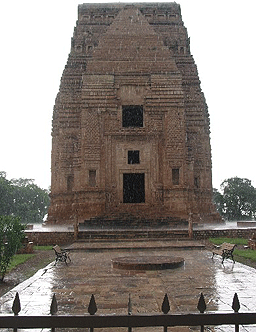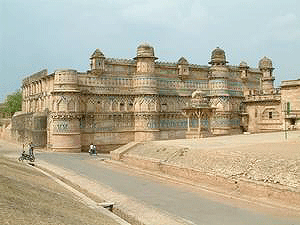|
|
|
Information about
Gwalior
|
|
Gwalior is the northernmost city of Madhya Pradesh. The city of Gwalior was founded by the King Suraj Sen and named after the saint Gwalipa, who cured his leprosy. Gwaliorís history can be traced back to 8 AD when the chieftain Suraj Sen was stricken with leprosy. A great saint Gwalipa, lived on the hill-top where the Gwalior fort stands. King Suraj Sen who ruled over the region, approached the holy man for cure of his leprosy. The holy man gave him water from the Surajkund, a water tank and the king was cured. Suraj Kund is still in the fort. The king established a town here and in gratitude, named the town after the saint Gwalipa. Gwalior is known for its historic massive 15th century fort. The distinctive and colourful hill fort of Gwalior on the north-south corridor was the key to control of the Central Provinces. Hindi and English are the main languages which are spoken here. The best season to visit Gwalior is from October to March. |
|
|
|
|
History of Gwalior
|
|
Gwalior was ruled by Suraj Sen. The saint Gwalipa gave the king a new name, Suhan Pal and directed him that so long as his descendants would retain the Pal name they would rule uninterruptedly. This lasted for 84 generations. The 85th descendant changed his name to Tej Karan and lost his throne. An inscription in the fort records that during the 5th century reign of Mihiragula the Hun, a temple of the sun was erected here. In more historical times, Gwalior came into limelight when Tomar Rajputs took power in 1398. Gwalior rulers became involved in wars with neighbouring kings. Man Singh Tomar who came to power in 1486 was the greatest of the Tomar Kings. He defeated the Lodhis of Delhi. When Sikandar Lodhi attacked again, Man Singh died but his son held the fort for one year. Muslim invaders like Qutb-ud-din-Aibak also ruled Gwalior before it passed into through a succession of Tomar Rajputs, Mughal, Afghan and Marathas. During the Mughal period, Babur was defeated but Man Singhís grandson continued to fight till Akbar became the Emperor. After the Mughals, the Marathas took over Gwalior and they were followed by the British. Maharaja Scindia sided with the British during the Mutiny but his forces did not. Gwalior was the scene of many bloody battles with the British in 1857. During the 1857 Mutiny, the Maharaja remained loyal to the British but his troops, 6500 of them, mutinied on Sunday June 14th. Next year, there was fierce fighting round Gwalior, the rebels being led by Tantia Tope and the Queen of jhansi. When the fort was taken by the British, the Rani was found dressed in menís clothes among the slain. Although the Maharaja of Gwalior had remained loyal to the British they kept the fort for another thirty years. |
|
|
|
|
Tourist Attractions in Gwalior |
|
The main tourist attraction in Gwalior is the Gwalior Fort and Teli-ka Mandir and Sas Bahu Mandir. The other tourist attractions in Gwalior are Man Mandir Palace and Vikramaditya Palace. |
|
|
Gwalior Fort
The Gwalior Fort, situated on the top of the hill dominates the Gwalior city. The fort is situated on a high sandstone precipice about 91 m above the surrounding plain and is 2.8 km long and 200-850 m wide. In some places the cliff overhangs, in other it has been scarped to make it unscaleable. The main entrance to the north comprised of a twisting, easily defended approach and the seven gates. These gates are Alamgiri, Hindola, Bhairon, Ganesh, Lakshman, Hathiapur and Hawa. Out of these seven gates only five remains. The walls are 9 m high and when seen from the north present a formidable battlement. On the west is the Urwahi gorge and another well-guarded entrance. There are many tanks on the plateau and the |
 |
|
Gwalior fort is one of the most impregnable fortress of north and central India. The first Mughal Emperor Babur also described the fort as the pearl amongst fortresses of Hind. There are 21 Jain sculptures that belong from the 7th to 15th centuries and of various sizes up to 20 m tall on the Urwahi Gate. Babur was offended by them and ordered their faces and private parts to be destroyed. But, now their faces have been repaired. Suraj Kund, where the Suraj Senís leprosy was cured by the saint Gwalipa is also situated inside the fort. It is a large tank and reservoir. |
|
|
|
 |
Teli-ka Mandir and Sas Bahu Mandir
The unique Teli-ka Mandir is about 30 m high and a Pratihara Vishnu Temple. This temple dates back to the 9th century AD and blends a number of regional styles. This temple has an interesting design, and the shape of the roof is in Dravidian style while the rest of the temple is covered with Indo-Aryan sculptures. A Garuda crowns the doorway. The Sas Bahu Mandir (Mother-in-law, Daughter-in-law temple) is also dedicated to Vishnu. This temple belongs to the 11th century. The larger of the two has an ornately carved base and four heavy pillar support the roof.
Vikramaditya Palace
The Vikramaditya Palace is located between the Man and Karan Palace. This place was built in 1516 and connected with the two palaces by narrow galleries. Inside the palace is an open hall with a domed roof. In the northern side and opposite the Dhonda Gate is the Karan
Mandir, a long double storeyed building with one large room and a roof supported on two rows of pillars. To the south is a hall with a Hindu dome room. |
|
|
|
|
Man Mandir Palace
The Man Mandir Palace was built by Raja Man Singh between 1486 and 1517. The exterior of the palace is built of red sandstone and decorated with blue tiles, elephants, yellow ducks and peacocks. The palace is richly ornamented and architecturally interesting. This palace also won the admiration of
Akbar. The walls are massive and elegant, and possess towers and atractive lattice work battlements. It is two storeys high with a further two underground floors complete with an ingenious ventilation system. In these under chambers, prisoners were tortured and killed and they were also used as a refuge when the fort was under attack. The upper rooms are arranged round two |
 |
|
courts and are small and beautifully executed. Many of the smaller rooms off the main court were used as bedrooms. The multiple iron rings in the ceiling were used for swinging cots and hanging screens. |
|
|
|
|
Lashkar
Lashkar means army camp which Maratha chief Daulat Rao Scindia had set up in 1809 to take control of Gwalior, to the south of the fort. The town later came to be known as Lashkar. The Jai Vilas Palace, King George Park and the chattris (memorial tombs) of the Maharajas are found in Lashkar. Jai Vilas Palace was designed by Lt. Col. Sir Michael Filose and was built in early part of the 19th century by the family of the Maharaja Scindia. This palace was completed in three years for the Maharaja Jayaji Rao who built it on borrowed English money. It is an enormous place, built in an Italian palazzo style. In the Durbar Hall, which is approached by a crystal staircase, hang the two largest chandeliers in the world. There is the largest carpet in Asia, an electrically-lit rock garden, and a silver electric train set which transported cigars and port round the dinner table. Half of the palace is still the residence of the current Maharaja, while the other part has been converted as a museum. The Muhammad Ghaus Tomb and the Tansen Tomb are also situated in this area. The Muhammad Ghaus Tomb is built in the form of a square with a hexagonal tower. The corners are surmounted by small domes, the interior of the building is enclosed on all sides by carved stone lattice screens. The Tansen Tomb is situated near the Muhammad Ghaus Tomb. Tansen was a famous musician who lived in Akbarís time and was one of the emperorís Nine Jewels of the Court.
|
|
|
|
Excursions from Gwalior
|
|
Shivpuri
The old summer capital of Shivpuri is situated about 117 km. south-west of Gwalior. The road to Shivpuri passes through the Shivpuri National Park. Shivpuri is also known for the Shivpuri National Park. Shivpuri was the summer capital of the Scindia Rulers and now a famous game reserve. The dense forests of the Shivpuri National Park consists of dry deciduous forest of dhok and were the hunting grounds for tigers and elephants of the Mughal Emperor Akbar. Its main mammals include nilgai, chinkara, chowsingha, sambar, cheetal and wild pig. There is also a large perennial lake. The lake attracts numerous waterbirds including migratory ducks and bar-headed geese which stay on until May. On its shores, you can see huge flocks of demoiselle cranes. The best months to visit Shivpuri National Park are from January to March. In Shivpuri there are also various tombs of the Scindia rulers. These tombs are set in formal Mughal style gardens with quiet nooks under flowering trees, interecting pathways and lit by ornamental Victorial lamps. Architecturally, they are a synthesis of Hindu and Islamic style with their Shikhara-type spires and Mughal pavilions. Near Shivpuri, there is a pleasant lake with gardens around its perimeter.
Narwar
Narwar is the beautiful old capital of Gwalior state and has been made famous recently by India Tourism Development Corporation by setting up tented accommodation at this beautiful place. Narwar also has a very large and old fort.
Datia
Datia is situated about 69 km from Gwalior. The Bundela chief, Bir Singh Deo was responsible for the fortress palace at Datia. Till the 1930, Datia was always on the standard itineraries of the British Viceroys. In 1902, Datia hosted Lord Curzon. The hill-top Gobind Palace is the famous palace at Datia. This seven-storey palace awed even the British architect Lutyens who was never an admirer of Indian architecture. He described this palace as one of the most interesting buildings architecturally in the whole of India. The palace is a fabulous maze of latticed corridors, verandahs, pillared cupolas and rooms with frescoes. Once these rooms were studded with semi-precious gems. The palace is surrounded by a 17th century stone wall.
|
|
|
|
|
|
How to get here |
|
By Air:
Gwalior is connected by Indian Airlines flights with Delhi, Mumbai, Bhopal, Indore. The airport is situated about 12 km from the city centre.
By Rail:
Gwalior is situated on the Central Railway line between Delhi, Mumbai and the Chennai-Delhi. It is directly connected by rail with Delhi, Amritsar, Mumbai, Bangalore, Bhopal, Jhansi and Agra.
By Road:
Gwalior is accessible on the NH3 (Agra-Mumbai) and on the State Highway from Jhansi. It is connected by road to Shivpuri, Indore, Ujjain, Agra, Jabalpur, Jhansi and Khajuraho.
|
|
|